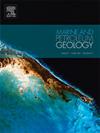Cenomanian channel system evolution of Mundaú Sub-basin deepwater, Brazilian Equatorial Margin: Reservoir characterization using machine learning techniques
IF 3.6
2区 地球科学
Q1 GEOSCIENCES, MULTIDISCIPLINARY
引用次数: 0
Abstract
Submarine channel systems have garnered significant attention in recent years due to their importance in petroleum exploration and favorable reservoir characteristics. Specifically, the Brazilian Equatorial Margin basins have attracted considerable interest from various sectors because of substantial hydrocarbon discoveries in adjacent basins. In the Mundaú Sub-basin (Ceará Basin, NE Brazil), recent studies have identified a series of sand-rich structures associated with a Cenomanian submarine channel system. However, despite these advancements, the depositional elements, sedimentary architecture, and stratigraphic sequences remain poorly understood. This paper aims to integrate robust quantitative geophysical techniques, including unsupervised machine learning methods, multi-attribute analysis, and RGB blending, to clarify the main evolutionary stages of the Cenomanian submarine channel-lobo system in the central portion of the aforementioned Sub-basin and their controlling factors. We utilized data from four exploration wells drilled in the deep waters of the Mundaú Sub-basin, along with a 2200 km2 seismic volume covering the study area. Our integrated approach identified three main evolutionary stages. The first stage is characterized by straight to low-sinuosity confined channels on the upper to middle slope, alongside poorly confined channels and splays on the lower slope to basin floor, primarily comprising sand-prone layers developed during a Falling Stage System Tract. The second stage exhibits low to moderate sinuosity confined channels in the upper to middle slope, with significantly poorly confined channels and splays on the lower slope to basin floor, also dominated by sand-prone layers developed in a Lowstand Tract System. The final stage features a high-sinuosity confined channel with dominant sand-prone and sand/mud-prone layers developed in a Transgressive System Tract. all stages and across almost the whole region, sand-prone and sand/mud-prone facies were identified and associated with various depositional elements at different scales. the presence of sand-prone layers in all stages is thought to result from high-density turbidity currents driven by a narrow shelf and stepped slope. The mapped features and predicted facies indicate an unexplored area with sand-rich layers likely possessing good lateral and vertical connectivity. Important structures that may facilitate oil migration were identified, highlighting the high exploration potential of the Cenomanian submarine channel system in the Mundaú Sub-basin.

巴西赤道边缘Mundaú次盆地深水塞诺曼期河道体系演化:利用机器学习技术表征储层
近年来,海底水道系统因其在石油勘探中的重要作用和有利的储层特征而受到广泛关注。具体来说,由于在邻近盆地发现了大量的油气,巴西赤道边缘盆地吸引了各个部门的极大兴趣。在Mundaú次盆地(巴西东北部ceear盆地),最近的研究已经确定了一系列与塞诺曼尼亚海底水道系统相关的富砂构造。然而,尽管取得了这些进展,沉积元素、沉积结构和地层层序仍然知之甚少。本文旨在整合鲁棒定量地球物理技术,包括无监督机器学习方法、多属性分析和RGB混合,以阐明上述子盆地中部塞诺曼尼亚海底通道-lobo系统的主要演化阶段及其控制因素。我们利用了在Mundaú子盆地深水钻探的四口勘探井的数据,以及覆盖研究区域的2200平方公里的地震体积。我们的综合方法确定了三个主要的进化阶段。第一阶段的特征是在上斜坡到中斜坡上有直到低弯曲度的封闭河道,在下斜坡到盆地底部有较差的封闭河道和带状河道,主要由在下降阶段体系域发育的易砂层组成。第二阶段在上斜坡至中斜坡发育低至中等曲度的封闭性河道,下斜坡至盆地底部发育明显的弱封闭性河道和带状河道,也以低洼地域体系发育的易砂层为主。最后阶段为高弯曲度封闭河道,主要发育海侵体系域的倾向砂层和倾向砂/泥层。在几乎整个地区的所有阶段,都确定了倾向于砂和倾向于砂/泥的相,并将其与不同尺度的各种沉积元素联系起来。所有阶段的易沙层的存在被认为是由狭窄的陆架和阶梯式斜坡驱动的高密度浊流造成的。图上的特征和预测相表明,这是一个尚未勘探的地区,富砂层可能具有良好的横向和纵向连通性。发现了可能有利于石油运移的重要构造,突出了Mundaú次盆地Cenomanian海底通道系统的高勘探潜力。
本文章由计算机程序翻译,如有差异,请以英文原文为准。
求助全文
约1分钟内获得全文
求助全文
来源期刊

Marine and Petroleum Geology
地学-地球科学综合
CiteScore
8.80
自引率
14.30%
发文量
475
审稿时长
63 days
期刊介绍:
Marine and Petroleum Geology is the pre-eminent international forum for the exchange of multidisciplinary concepts, interpretations and techniques for all concerned with marine and petroleum geology in industry, government and academia. Rapid bimonthly publication allows early communications of papers or short communications to the geoscience community.
Marine and Petroleum Geology is essential reading for geologists, geophysicists and explorationists in industry, government and academia working in the following areas: marine geology; basin analysis and evaluation; organic geochemistry; reserve/resource estimation; seismic stratigraphy; thermal models of basic evolution; sedimentary geology; continental margins; geophysical interpretation; structural geology/tectonics; formation evaluation techniques; well logging.
 求助内容:
求助内容: 应助结果提醒方式:
应助结果提醒方式:


